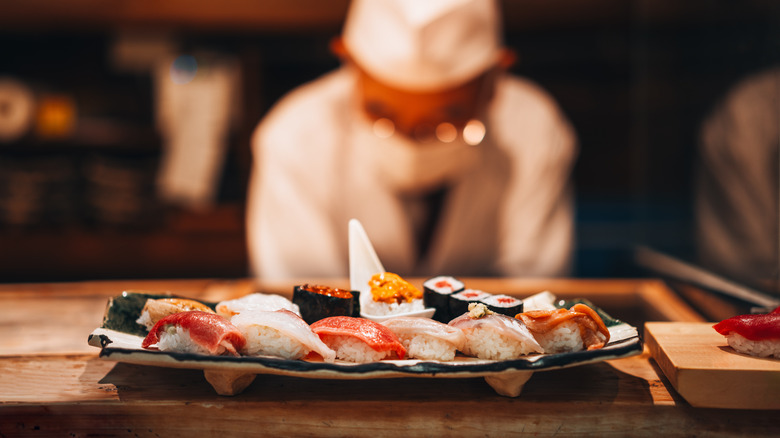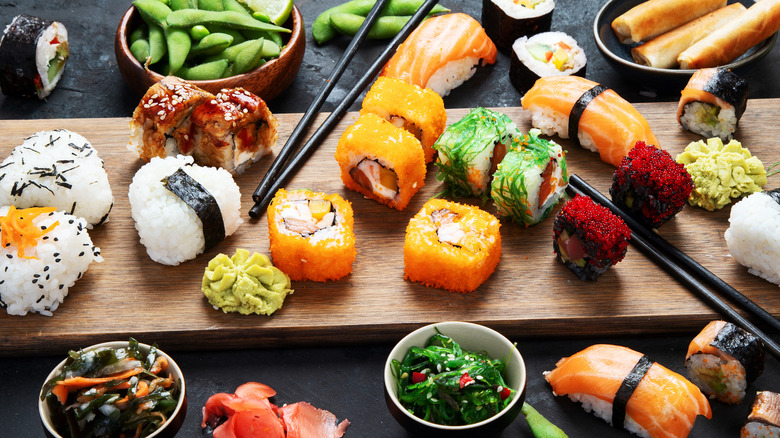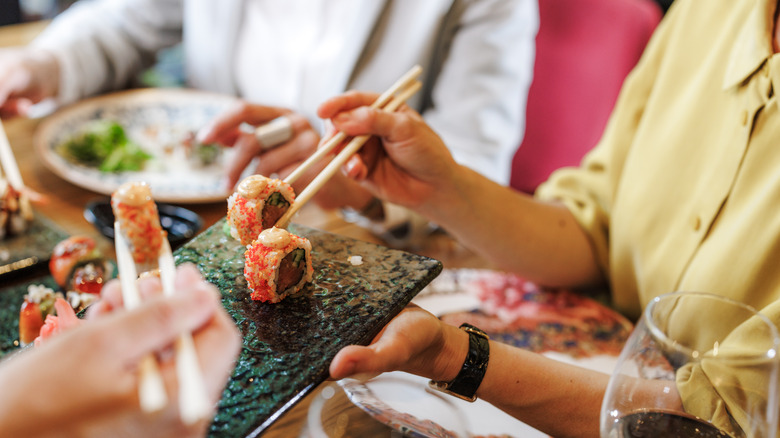What Is Omakase? What You Need To Know Before Dining
Sitting down to an omakase-style meal probably feels a bit like sitting down for dinner with a celebrity chef at their home. It's kind of a big deal. However, instead of being at the chef's home, guests are invited to sit at the chef's counter at a restaurant. And just as the host of a dinner party chooses the menu, the Japanese sushi chef does, too. In other words, for restaurant guests, what's for dinner comes as a bit of a surprise. Even the translation of the word "omakase" spells out the guests' role in the evening's festivities: "I leave it up to you," with the "you" being the chef in this case, and not the guests. The chef, like the celeb chefs of TV, is really the star of the meal here.
By all accounts, an omakase feast is a distinguished affair — an anthology of courses the chef dreams up — based on the seasonal offerings from the local fish market. Most of the time, guests will be eating sushi and sashimi dishes for the bulk of their meal, though the chef might add other menu items into the mix. It's usually a very leisurely meal, with anywhere from nine to 15 courses passing from chef to guest. However, it's not a drive-thru. If you're interested in trying omakase and don't have at least two or three hours to spare, it's best to give it a go another night.
How the chef knows what to serve
Omakase may also be as close to culinary diplomacy as you'll get at a local restaurant. Ideally, the repartee between host and guests flows as easily as the sake and green tea does. It's meant to be intimate and a relationship-builder, where the guests learn about the chef's experience, and the chef learns about the guests' tastes.
It might be a curated meal that starts with the day's deep-sea delicacies. However, if, after trying the first course or two, the guests' demeanor suggests they'd rather have the catch of the day thrown back, the chef usually adjusts the plan for dinner. That said, the diners who enjoy omakase-style meals the most are the ones who come to the table with tummies hungry for fish and minds thirsty for new experiences.
Deep pockets don't hurt, either. This meal may run you upwards of $500 per person, though $100 or so tends to be more typical. Many restaurants that serve omakase meals may only see three rounds of guests a night, with a maximum of 10 guests per round. To stay afloat, the restaurant charges more to offset the length of time the chef spends with guests. Still, despite the cost and an understanding that guests won't be ordering their own sushi, many omakase restaurants have reservation lists that extend weeks, even months out.
Etiquette at the omakase table
Trust is the operative word when you're sitting at an omakase meal. That is, you trust the chef to select food items that will appeal to you, based on a symmetry of sometimes contrasting flavors. In light of that, it's understood that diners don't ask the chef to substitute one thing for another on the night of the event. If you must have something substituted, due to a food allergy, for example, it's best to give the restaurant a heads up when setting the reservation.
Dinner etiquette also includes various expressions of appreciation to the chef. "Itadakimasu" means you offer the host gratitude for your meal before it's made. "Gochisōsamadeshita" also means "thanks," but it's the well wishes you extend to the chef after the meal ends. If you'd like to let your host know that everything is next-level good, say "Oishikatta desu" to tell them that the work they did tasted delish.
Finally, there is an unspoken dress code for attending an omakase meal. Slacks or skirts topped by blouses or button-down shirts are the norm. Those inclined towards a more formal dress code might also wear a jacket. And it might go without saying, but sneakers are a no-go. The celeb chef analogy works here, too. If your favorite TV gourmand invited you to dinner, you'd dress for the occasion. Omakase is an occasion and the sushi chef is the celeb of the night, so you should dress for the event that it is.


